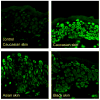The protective role of melanin against UV damage in human skin
- PMID: 18435612
- PMCID: PMC2671032
- DOI: 10.1111/j.1751-1097.2007.00226.x
The protective role of melanin against UV damage in human skin
Abstract
Human skin is repeatedly exposed to UVR that influences the function and survival of many cell types and is regarded as the main causative factor in the induction of skin cancer. It has been traditionally believed that skin pigmentation is the most important photoprotective factor, as melanin, besides functioning as a broadband UV absorbent, has antioxidant and radical scavenging properties. Besides, many epidemiological studies have shown a lower incidence for skin cancer in individuals with darker skin compared to those with fair skin. Skin pigmentation is of great cultural and cosmetic importance, yet the role of melanin in photoprotection is still controversial. This article outlines the major acute and chronic effects of UVR on human skin, the properties of melanin, the regulation of pigmentation and its effect on skin cancer prevention.
Figures


References
-
- Gilchrest BA, Eller MS, Geller AC, Yaar M. The pathogenesis of melanoma induced by ultraviolet radiation. N Engl J Med. 1999;340:1341–1348. - PubMed
-
- De Fabo EC. Arctic stratospheric ozone depletion and increased UVB radiation: potential impacts to human health. Int J Circumpolar Health. 2005;64:509–522. - PubMed
-
- Kripke ML. Impact of ozone depletion on skin cancers. J Dermatol Surg Oncol. 1988;14:853–857. - PubMed
-
- Holzle E, Honigsmann H. UV-radiation--sources, wavelength, environment. J Dtsch Dermatol Ges. 2005;3 2:S3–10. - PubMed
-
- Ullrich SE. Photoimmune suppression and photocarcinogenesis. Front Biosci. 2002;7:d684–703. - PubMed
Publication types
MeSH terms
Substances
Grants and funding
LinkOut - more resources
Full Text Sources
Other Literature Sources
Medical

